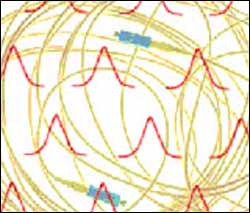Super slow light may help speed optical communications

Light waves that travel very slowly without distortion could eventually help simplify and reduce the cost of high-speed optical communications.
Light is so fast that it takes less than 2 seconds to travel from the Earth to the moon. This blazing fast speed is what makes the Internet and other complex communications systems possible. But sometimes light needs to be slowed down so that signals can be routed in the right direction and order, converted from one form to another or synchronized properly.
Now, physicists at the National Institute of Standards and Technology (NIST) have proposed a new way to slow light down to almost one-millionth its usual speed–to the mere speed of a jet aircraft. As described in the Oct. 1 issue of Physical Review Letters,* the method eventually could help simplify and reduce the cost of high-speed optical communications. The paper presents mathematical calculations proving the existence of a new class of “soliton,” a solitary light wave that can propagate over long distances without distortion even when moving very slowly through an ultracold gas.
Solitons first were discovered in the 1800s when a naval engineer observed a water wave travel more than a mile within a canal without dissipating. Light wave solitons generated within optical fibers are now the subject of intense research worldwide. Their very short, stable pulse shapes might be used to pack more information into fiber-optic communication systems. But when previously known forms of optical solitons are slowed down, attenuations and distortions (and therefore losses of data) occur quickly, before the light has traveled even 1 millimeter.
NIST physicists showed it is possible to use a very stable pulsed laser to create a soliton that travels slowly through a cryogenic gas of rubidium atoms for more than 5 centimeters without noticeable distortion. The scientists now plan to translate the theory into practical experiments. Currently, 300 kilometers of fiber are required to delay an optical signal for one thousandth of a second, whereas only a few centimeters of fiber might be needed using the new class of soliton.
Media Contact
More Information:
http://www.nist.govAll latest news from the category: Physics and Astronomy
This area deals with the fundamental laws and building blocks of nature and how they interact, the properties and the behavior of matter, and research into space and time and their structures.
innovations-report provides in-depth reports and articles on subjects such as astrophysics, laser technologies, nuclear, quantum, particle and solid-state physics, nanotechnologies, planetary research and findings (Mars, Venus) and developments related to the Hubble Telescope.
Newest articles

Pinpointing hydrogen isotopes in titanium hydride nanofilms
Although it is the smallest and lightest atom, hydrogen can have a big impact by infiltrating other materials and affecting their properties, such as superconductivity and metal-insulator-transitions. Now, researchers from…

A new way of entangling light and sound
For a wide variety of emerging quantum technologies, such as secure quantum communications and quantum computing, quantum entanglement is a prerequisite. Scientists at the Max-Planck-Institute for the Science of Light…

Telescope for NASA’s Roman Mission complete, delivered to Goddard
NASA’s Nancy Grace Roman Space Telescope is one giant step closer to unlocking the mysteries of the universe. The mission has now received its final major delivery: the Optical Telescope…



